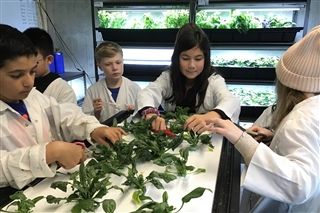The Junior School is now home to a hydroponic growing space! A collaborative project between Grade 5 Teachers Mrs. Sarah Wallace and Mrs. Rhonda Stark and Allan Murr from Harvest and Share Food Relief Society, funding came from generous GNS donors and external sponsorships organized by Allan from groups such as the City of Victoria. This is the first hydroponic growing space to be built in a school in Victoria.
The idea for this project was conceived two years ago when Mrs. Wallace visited Government House and saw metal pyramids that run on an aeroponic system growing vegetables outdoors between April and September without the use of soil. In the IB PYP unit of inquiry Sharing the Planet, the Grade 5s look at finite resources, and soil is one of them. The idea of growing vegetables without soil sparked an idea in Mrs. Wallace’s mind for connecting this concept with her Grade 5 curriculum.
This year, Mrs. Wallace was able to get in touch with Allan, the creator of the pyramids. This connection was made with perfect timing as Allan revealed that he was in search of a school that would be interested in building a hydroponic growing space.
“Having the hydroponic space fits in with Nature School, and this is the first time we have done it with the Grade 5s,” explained Mrs. Wallace. “It would give them a project that would marry both science and sustainability, and the opportunity to produce food that we can give to food banks.”
Mr. Murr said he’s appreciative of the space and is excited to explore the possibilities it provides. This is the first school he has worked with.
“It is amazing to have that space available to us,” he said. “It’s a great partnership that we have because it’s a twofold project. There’s the educational aspect of it for the Grade 5 students, and then they all know when it comes time to harvest, it will all go to Backpack Buddies, which is a children’s organization.”
The food harvested from the hydroponic space is donated to Backpack Buddies, a program that seeks to bridge the weekend hunger gap by providing a weekly bag of food to children who are supported during the week by school breakfast and lunch programs across Vancouver Island and the Lower Mainland. That means that the Grade 5 hydroponics project is providing our students with an opportunity to help other kids in their local community.
The GNS hydroponic space employs the Kratky Method, which differs from an aeroponic system. This method has plants that are suspended above a reservoir containing a nutrient solution. As plants access the water, the nutrient solution levels fall. As the solution levels get lower, the roots of the plant grow downwards to access more resources.
“The appealing thing for us is that it is passive, we can set it up and leave it,” added Mrs. Wallace. “We are going to start with spinach because it’s easy to grow. So, we can grow a crop of spinach in a three-week period, and then harvest it. We will have different crops coming at different times and we can provide food for food banks all the way through the year. For food sustainability, production and food stability it’s massive.”
Grade 5 students were officially introduced to the new space on November 17, and smiles were plentiful as Allan came to speak with the students about the space they were going to be learning in.
“I think the hydroponics space is quite cool because you can grow plants without any dirt,” said Blue Heal ’30. “It’s with all the nutrients, and everything is the same just without the dirt. It’s been going great. We have harvested a lot of radishes and spinach.”
“It’s really cool planting and being involved with the plants, and it’s nice that we can donate it to Backpack Buddies,” added Jada Baterina ’30. “My favourite part has been seeing how the plants grow in this room with the light and the water. It’s really cool to see how it develops.”
The students have been coming up with different growing experiments to try within the space. Students have taken different seeds and explored different planting methods and come up with hypotheses of how the seeds will respond. Some of the seeds are soaked and others are not. Some plantings use just cuttings in water, while some have used grow grips. This exploration of ideas fits well within the Design Cycle (Ask, Imagine, Plan, Create and Improve), something students in the Junior School use throughout their studies. Projects like this help students to develop the thinking and application skills they will need to apply when they begin working on their IB PYP Grade 5 Exhibition.
“It’s been really great so far,” said Rose Moss ’30. “We have been working on growing the snippings from Allen’s garden, and growing our own from seeds. My favourite part has been the germination. We had a bin and mesh inside and dropped seeds in it and sprayed it with water to make it damp. Once they were damp we put the lid on and they started growing roots and sprouts.”
“It’s been really fun and feels really good knowing that we are giving a donation to Backpack Buddies,” added Gabriella Ward ’30. “I like working in the hydroponics lab because I like to see what types of techniques can work in the future. My parents like to garden, so maybe I can do this at home.”
The Grade 5s currently have been sharing their ideas about the hydroponics lab with their Grade 2 and Junior Kindergarten buddies, but the hope is to eventually get inter-school collaboration, with some of the older students coming to the Beach Drive Campus to work with them.
“It fits beautifully with the IB Diploma Programme and the independent assessments that students do,” said Mrs. Wallace. “The kids are getting a lovely segway into service as well. It’s a meaningful service kids can be involved in. We are extremely excited.”





